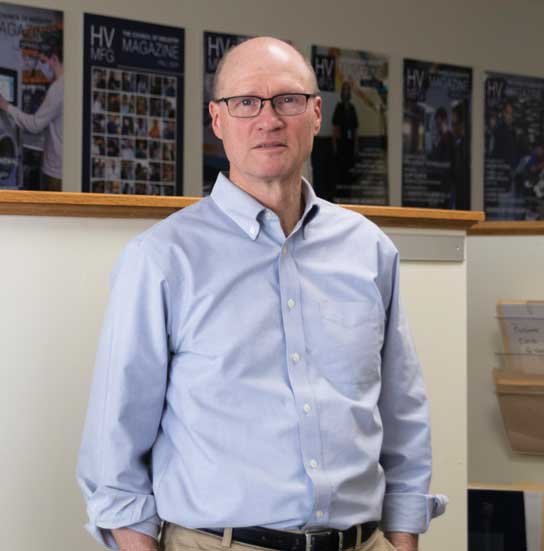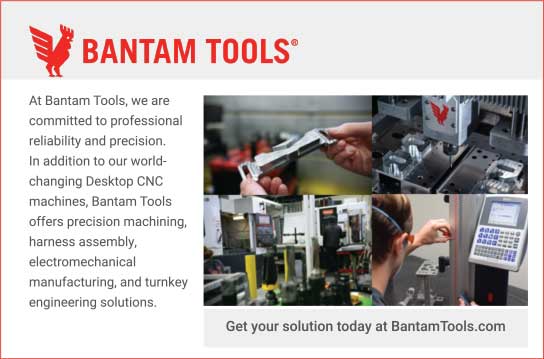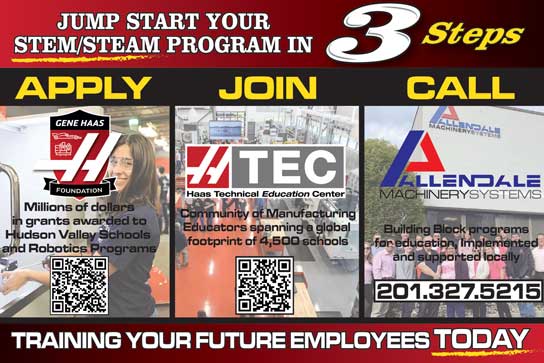AD ESSENTIALS | BY LINDA ENGLER
A DECADE OF STORIES
An interview with the interviewer.

Harold King, President of the Council of Industry, reflects on 10 years of Q&As with leaders from the Hudson Valley manufacturing community.
LE: Hi Harold. And I’m delighted to be here with you as your interviewer today, as you know this isn’t my typical role, but we have a lot of history.
HK: We do have a lot of history. And, it’s fun to reminisce.
LE: A lot has changed over time. I remember when you were stapling pages together to mail the directory. It must be rewarding to see how far it has come.
HK: I’ve been with the Council since 1990 and yes, things have changed. Before publishing the magazine, we printed an annual member directory. I would literally copy pages and staple them together. It was an exciting advancement when we started working with you to publish it professionally with fancy color covers and everything. It moved the association light years ahead and ultimately laid the foundation for the magazine.
LE: The evolution to a biannual manufacturing magazine was a significant commitment. Talk a little about how that decision was made and the purpose of the publication.
HK: We had a long and well-facilitated conversation at a board retreat to figure out why nobody understood what modern manufacturers were doing in the region. We had a series of challenges primarily around workforce, but also around legislative decisions, regulations, and laws that were passing. Our members were concerned that schools were not turning out the kind of workforce our sector needed, and we wanted to determine the actual source. We figured out it was a lack of awareness or unintentional ignorance about what was happening. At that time, manufacturing was seen as declining and moving overseas, not significant or important, and the focus was elsewhere. We decided to publish the magazine to tell their stories and shine a light on the companies, leaders and the issues facing Hudson Valley Manufacturers.
LE: How did you decide on the content and article formats?
HK: The directory had lengthy company descriptions but didn’t tell any stories. It wasn’t designed to highlight innovation, creativity, and the constantly evolving sector. One of the fun things about manufacturing in the Hudson Valley is that our manufacturers make a lot of things that go into other things. It’s not always finished products that people might know, but parts of cars or components for electronic devices. It might not be the iPhone or laptop, but they supply circuit boards or semiconductor chips that give products functionality. That story is a little more complicated to tell but it needs to be told.
LE: There are so many different types of manufacturing companies in the Hudson Valley with innovative leaders, how do you choose who to profile in each issue of HV Mfg?
HK: There really isn’t a formula. Sometimes it’s somebody we want to recognize and acknowledge, or a person with a great story to share. I know most of the folks who are involved with the association, at least at the senior level, but occasionally we hear about someone, and we want to get to know them better. Most often, it is a person or company who is particularly engaged. We also think about variety. Whenever possible we like to highlight successes throughout the region, with companies from Westchester to Ulster County, we want to make sure we are sampling from everywhere. We also want to emphasize the industry—maybe they are making an interesting product, celebrating a business milestone, or innovating a unique technique.
LE: When discussing the concept of the magazine did you already have someone in mind for the first issue interview?
HK: We did have a first interview in mind and wanted it to be someone I knew well, who was interesting, and passionate about leadership. Scott Hutchins was the president of our board at that time, had worked in several businesses, and was an entrepreneur. At the time he was working with Jabil as a contractor for IBM. He was a great first interview.
LE: You have had the opportunity to interview many individuals over the decade. Does anyone stand out to you? What makes them top-of-mind?
HK: There are so many interesting people, I suppose each stands out in their own way. There have been 20 editions of the magazine but only 19 with leader profiles. The “pandemic issue” of spring, 2020 is the one that doesn’t include a profile. We instead chose to profile several people and organizations that were having a big impact on public health and keeping the economy working instead.
I interviewed Rich Goldberg, Vice President of Operations at President Container, right before the pandemic hit and his profile ran that Fall. His interview stands out because he really surprised me. He shared his background in computer science and accounting and talked about his work in Italy for several years and how he found his way to this industry. I had known him for so long and didn’t know about his unique past and wide-ranging experience – you think you know a guy…
Ben Katzenstein from Star Kay White was a great interview for me. The experience of being in his office surrounded by books and history, the overall atmosphere was fascinating. He talked about not wanting to be part of the family business and then embracing it fully, bringing it to a fifth-generation company. He is a really nice person. It was great to get to know him, and we’ve built on that and formed a working relationship.
I enjoyed talking with Gretchen Zierick, President of Zierick Manufacturing. She was the first woman we interviewed. She is such an impressive leader. It can tough being a female engineer, particularly one from her generation, and even tougher taking the business over from her father. She acknowledged the bias from the industry and even within her own family; it was something she had to overcome. She is now on our board and deeply committed to developing and empowering the next generation of women in the field.
Everyone I’ve interviewed is of the firm but fair philosophy: they treat their employees with respect… they invest in their development.
LE: Many of the leaders you have interviewed are carrying on a family business. Which of those interviews stand out to you the most?
HK: The ones that are the most interesting to me are those where I know two generations. It is a privilege to watch people like Jason Smith take on the responsibilities at the Pawling Corporation from his father, Roger, someone I valued as a mentor. Jason has that same confidence and business acumen as his dad, he’s a straight shooter and honest with a terrific sense of humor, evidently the same as his father. He saw opportunities with the business and has taken some different paths, which have been good for the company.
Darren Doherty’s stewardship at Package Pavement has been very impressive. Darren is the third generation and in the next few years he will be handing it down to the fourth. Rich Croce from Viking Industries has a story of ups and downs. He is like his father, a good friend of mine, patient, and communicative. Rich is an intentional leader and thinks about his impact on others, which he takes very seriously. He is very involved with the P-TECH school and is a great role model.
I met Bianca Vogel-Quigley in 1986 through the United Way, she took over her family business, several years later, ErtelAlsop. During my interview with her she discussed the difficulties starting her career in engineering, even her father discouraged her from pursuing. Now she and her husband George lead a successful growing business. It was fun interviewing her and rewarding to see her success.
LE: Do you think multi-generational family business owners offer a different perspective than an entrepreneur?
HK: It’s different, that’s a good point. They have a different kind of obligation and stewardship. There’s both family pressure and business pressure, they don’t want to be the generation that changes the momentum, but they usually have depth of expertise and institutional knowledge. If they are lucky, they can seek advice from their parents and after evaluating they can make their own informed decisions.
But there’s something to be said for the innovative entrepreneurial folks like Elisha Tropper, who bought Cambridge Security Seals, had a vision and has dynamically changed that business. He’s doing fantastic things there. Or Cedric Glasper, who is leading Mechanical Rubber Products to new heights. Bre Pettis is fascinating—from inventor and entrepreneur, to working with Jim Henson’s puppets, to creating a 3D printing business, to building desktop CNC machines. I interviewed him for this issue. That is a very different model than the third, fourth, or fifth generation company that has been a member of the Council for 113 years, but they all have great stories.
LE: Do you find that there are any common characteristics with member manufacturing leaders? What do you attribute to this?
HK: Everyone I’ve interviewed is of the firm but fair philosophy: they treat employees with respect. They recognize that the success or failure of the business is dependent on their employees, and they invest in their development. They are effective communicators, some are soft, and others are more direct, but they all relate to their employees effectively. Rich Croce said it best, “Tell people what you expect, then expect them to do it, then hold them accountable.” This is a common theme; consistency is important.
LE: You have also interviewed community leaders and educators. Is there someone who stood out to you for the impact on the community and manufacturers in the region?
HK: I really enjoyed talking to Don Christian, former president of SUNY New Paltz. I knew he had a biology and science background, but I didn’t know how much this influenced him to become a leader and decision-maker. It was great to hear him reflect on his surprise turn from being a teacher to an administrator and how rewarding that was for him. The Council works closely with the business and engineering programs and the college gives us a lot of credit for helping to get the mechanical engineering program off the ground. It was nice to reflect with Don about the progress that has been made on campus throughout his tenure and that of his predecessors. It’s gratifying to see so many engineering students working with our member firms. He has had such an influence on the manufacturing sector through his post as SUNY New Paltz president, it wasn’t a stretch to feature him in our Leader Profile section and it was well received.
There is so much expertise in our network and the magazine is an excellent way to share it with our members and the manufacturing community.
LE: You mentioned the purpose of the magazine was to tell stories and inform decision makers, legislators, educators, and the community about the importance of manufacturing. Has it been successful?
HK: As you know, we publish more than 3,000 copies and send them to those people throughout the region. Our success is in the experience and feedback. Every time someone says “I didn’t know” or “great article about …” we can feel the awareness shift.
Sometimes you can see the direct impact, like in 2017, when I got a phone call from the Pine Bush High School principal, Aaron “Hop” Hopmayer. He said, “Hi, Mr. King, I got your magazine. This is great. I want you to know, we’re trying to do some stuff around manufacturing here too. Can I meet you?” We met and I learned that they had applied for a grant through Allendale Machinery Systems and the Haas Foundation to buy a CNC machine to upgrade their technology. We immediately partnered with Hop and his team to introduce them to key people, companies and programs including the SME PRIME school. A couple years later, they were awarded a million-dollar naming grant from the Haas foundation and are expanding their facility and sending graduates into the workforce and engineering programs throughout the country.
LE: And you also featured Aaron Hopmayer in a leader profile in the magazine?
HK: Yes, the Aaron Hopmayer interview was the first time a non-manufacturing person was featured in a leadership role. This is a different type of leader, a school principal who has taken on the mission, as Hop always says, “If it’s good for the kids, we’ll try it.”
LE: Aside from the leader profiles, the magazine has featured articles about innovation, energy, supply chain, and workforce. Are there any specific articles that stand out?
HK: Well, not so much individual articles as contributors, there are a few that stand out for various reasons. I really like the fact that we have been able to use the magazine to share the expertise of our associate members. We have had important articles written on everything from energy policy to recruiting strategies, from strategic human resource management to tax policy, and from immigration to supply chain management. And so much more. There is so much expertise in our network and the magazine is an excellent way to share it with our members and the manufacturing community.
We also have gotten some great work from our current and former staff. Interviews with emerging leaders and profiling companies are rewarding and gives the magazine some dimension. I may be a bit biased, but the contributions David King wrote on innovation and emerging technologies were some of the best, most read articles we published.
LE: There is so much more we could discuss. Would you like to add anything?
HK: This has been fun. I have a great job and get to meet and work with creative, smart, interesting people. I am extremely fortunate to work with you and the team here at the Council on this project.
LE: Thank you so much. It was so good to take this look back with you.
HK: It’s been a fun 10 years—if we are fortunate there will be 10 more.






